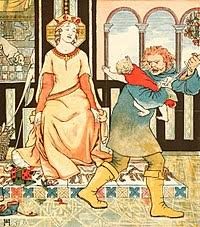Liz Stanley

It is the late 1340s and a pandemic – the Black Death, the bubonic plague – is raging. Increased numbers of people are dying day on day, no one knows how to stop it, friends and family shun each other, the ordinary sense of time and space and social connectedness is dislocated. A group of acquaintances, seven women and three men, come together, deciding to isolate themselves from the city for a two-week quarantine period and to do so in a thoughtful and mindful way. They gather together for the lockdown period. And they tell each other stories, the stories of their times – 10 days, 10 people, 100 stories. This is the setting for Boccaccio’s The Decameron.
Even people who don’t know anything much about The Decameron [the hundred stories] beyond its title have often heard of ‘patient Griselda’, a folklore figure, as well as appearing in this book. Griselda is a woman who bears no anger or resentment, no matter how ill-treated she is by the pig of a man she is married to; and she appears in the last of its stories, the tenth story told on the tenth day. However, from the (symbolic) names of its ten storytelling characters, through to the time and place of the stories they tell, there is little about the contents of The Decameron that can be taken straightforwardly at face value.

The final story is that of patient Griselda, but it is impossible to think that the book’s seven feisty women storytellers would have been anything other than impatient and annoyed with such a misogynistic idea of what a perfect woman would be like – thought of on the surface Griselda is a bully’s wet dream, and in her case the bully-husband is the Marquis of Saluzzo while she was a peasant by birth. In our present pandemic times, the figural ‘she’ here has a particular resonance, given the vast increase in domestic violence that is being recorded in current lockdown circumstances in many different parts of the world. So why does the book close with this, at the point where the assembled ten storytellers are about to return to Florence and the plague? What point are readers are expected to take from it?
All the ten last stories in The Decameron are about good and bad behaviour in sexual, marital and other relationships, so it is possible to read it as the swinish husband being a way of heaping praise on the more than perfect conduct of Griselda, a goody two-shoes if ever there was one, indeed so perfectly forgiving as to be quite impossible. But while it is preceded by nine other good conduct stories, it is immediately followed by an epilogue which provides another way of understanding it. In the ‘Author’s conclusion’, Boccaccio steps forth and directly addresses the reader, which the authorial ‘he’ does earlier in the book too. He says that these are stories of the times, they deal with things that happen although they may infringe how things are spoken and written about in more ordinary circumstances (with this directed most to the bawdy sexual content of a number of them), that ‘the ladies’ who he is addressing should take from them the lessons they want, and that his intentions as an author are signalled in the ‘sign on its brow’ over each of the stories. This is the summary or abstract that proceeds each of the hundred stories. In the case of patient Griselda, the ‘sign on its brow’ is in effect entirely about the husband and his ill-conduct. His misogyny is defeated in the end by her perfections, she is celebrated as the heroine of hour, she enters glory in the city of Saluzzo.
But what of now? A Griselda for our time is not a textual device for pointing up and ‘rescuing’ the ill-behaviour of men. A Griselda for our time is a very, very impatient woman. She views the upturn in domestic violence towards women as appalling. She notes that the vast majority of frontline care work in the present pandemic is being done by badly paid women. For impatient Griselda there is no return to the city, she probably heads for a domestic violence refuge somewhere – or perhaps she becomes a care worker.
